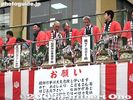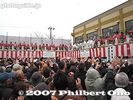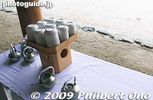 Image search results - "shinto" Image search results - "shinto" |

Nose Myokenzan Betsuin at a street corner. In Feb., priests at this small temple splash cold water on themselves for 30 min. Near Honjo-Azumabashi Station on the Toei Asakusa Line or JR Kinshicho Station on the Sobu Line.
|
|

Shrine hall
|
|

Barrels of cold water in front of shrine
|
|

Barrels of cold water
|
|

The congregation gather on the steps and beat fan-shaped drums.
|
|

Priests appear
|
|
|
|
|
|

Nagahama Hachimangu Shrine torii on New Year's Day. Nagahama's most popular shrine for New Year's worship (hatsumode). MAP
|
|

Chanting prayers
|
|
|

Tagata Shrine torii and entrance 田縣神社
|
|

Path to shrine with stone lanterns, and cars.
|
|
|

Tagata Shrine stone marker
|
|

Stone lanterns
|
|
|

Mikuji paper fortunes for love and romance, marriage, and childbirth.
|
|
|

Priests splash cold water over themselves at the Nose Myokenzan Betsuin in Sumida-ku, Tokyo
|
|

Tagata Shrine Honden main hall. Komaki, Aichi Pref.
|
|

The shrine grounds was filled with cars on New Year's Day. Apparently, the shrine has no parking lot.
|
|
|

Tagata Shrine Honden main hall which worships shrine worships a deity called Tamahime-no-Mikoto who was a daughter of a powerful local lord from the 5th century.
|
|

Another entrance to the shrine
|
|

Hachimangu Shrine torii
|
|
|

Torii to Oku-no-miya Shrine, next to the Honden main hall.
|
|
|

Hachimangu Shrine torii
|
|
|

Stones and Oku-no-miya Shrine
|
|
|

Hachimangu Shrine
|
|
|

Haiden hall 拝殿
|
|

Hachimangu Shrine. Do not climb on the horse.
|
|

Filled with a water hose
|
|

This is what you see inside Oku-no-miya Shrine. A giant wooden phallus offering.
|
|

Ice sculpture of two rats. 2008 is the year of the rat.
|
|
|

Oku-no-miya Shrine also has many other phallic objects presented as offerings. There even one which you can touch...
|
|
|
|
|

Apparently it can become erect too. (Compare with previous photo.)
|
|

Honden Hall 本殿
|
|

Phallic objects
|
|

New Year's prayers amid snow.
|
|

Note that the phallus is not the object of worship. It is an offering to the god.
|
|

Buying omikuji fortune paper
|
|
|

Shrine souvenirs
|
|

Votice tablets written with people's wishes for love, sex, and babies.
|
|

Votive tablet
|
|

Place to rub the sacred balls. 珍宝窟
|
|
|
|
|
|
|

Torii to Benzaiten Shrine
|
|

Rub the two balls.
|
|

Benzaiten Shrine
|
|

Put in money and it will make a "chin" sound. (From the word "chinpo" for penis.)
|
|

Benzaiten Shrine
|
|

Phallic fence posts.
|
|

Torii to Tenmangu Shrine 天満宮
|
|
|

Tenmangu Shrine 天満宮
|
|

Phallic rock. There are several phallic rocks donated by various people. Apparently they are either natural or carved.
|
|

Omikuji tied on tree branches
|
|

Best-looking phallic rock.
|
|
|
|
|

Fire bringing warmth
|
|

Female and male rocks.
|
|
|
|

Behind the rocks are two trees bonded together.
|
|

Basho haiku monument
|
|

Nearby Hachiman Shrine.
|
|

Another pair of trees bonded together.
|
|

Hachiman Shrine torii
|
|

Gozensai prayer ceremony before the start of the procession.
|
|

And another...
|
|

Gozensai ceremony before the start of the penis procession. Tagata Shrine Honen Matsuri
|
|
|

The short prayer ceremony ends.
|
|
|

Mikoshi (portable shrine) bearers gather in front of Kumano Shrine.
|
|

Worst-looking phallic rock. That's stretching the imagination a little too much.
|
|

Sake
|
|

Votice tablet with illustration of the Honen Festival.
|
|

Breaking the sake barrel
|
|

Phallic souvenirs.
|
|

Sake flows freely.
|
|

People waiting for the procession along the shrine steps. (Not a good place to watch the procession.)
|
|

People waiting for the procession in front of Kumano Shrine.
|
|

Men in happi coats which read "Honen Matsuri." Honen literally means "year of abundant harvest."
|
|

The procession is ready to start from Kumano Shrine.
|
|

People waiting for the procession in front of Kumano Shrine.
|
|

Sarutahiko-no-Okami, the deity who led the descent of Amaterasu (Sun Goddess) from heaven to earth.
|
|

The procession goers down the slope in front of Kumano Shrine.
|
|

The first mikoshi is for Takeinadane-no-Mikoto coming to visit his wife of Tamahime at Tagata Shrine, where Tamahime's residence was located.
|
|

Takeinadane-no-Mikoto
|
|

The second mikoshi features the giant penis carried by 12 men at a time, all of whom are age 42, considered to be an unlucky age (yakudoshi) for men. They seek protection by carrying the phallus.
|
|

The giant phallus by itself weighs about 280 kg (620 lbs.). The total weight of both the phallus and portable shrine housing is 400 kg (885 lbs.).
|
|

The giant phallus is called "O-owasegata." It is an offering, and not a deity nor object of worship. Tagata Shrine Honen Festival. A total of 60 men take turns carrying the giant phallus portable shrine. 大男茎形
|
|

Next is a palanquin (not mikoshi) for the Toshi-gami deity of harvests. 御歳神
|
|

Toshi-gami deity of harvests is pulled on a palanquin instead of being carried.
|
|

Toshi-gami deity of harvests.
|
|
|

More steps...
|
|

Where the penis goes, the crowd follows.
|
|

Oh my God, more steps...
|
|
|

Musashi-Mitake Shrine
|
|

Also see the video at YouTube. Honen-sai Festival, Tagata Shrine Honen Festival.
|
|

Musashi-Mitake Shrine, Tokyo 武蔵御嶽神社
|
|

They spin around the phallus.
|
|

Musashi-Mitake Jinja 武蔵御嶽神社
|
|

Maidens who are 36 years old, carry wooden penises for protection during their "unlucky age" (yakudoshi).
|
|

The shrine buildings at rear.
|
|
|

View from the shrine, not much.
|
|

Portable shrine for Takeinadane-no-Mikoto
|
|

But there was one clear pocket of scenery.
|
|
|
|

The route is short, but it's a slow procession with many short breaks. The procession lasts 1.5 hours.
|
|

Omikuji
|
|

Takeinadane-no-Mikoto
|
|

Omikuji
|
|

The first half of the route is quite narrow.
|
|

Treasure House 宝物殿
|
|

Sake cart
|
|

Musashi-Mitake Shrine, Tokyo
|
|

Salt sprinkler heads the procession to purify the way.
|
|

Sarutahiko-no-Okami, the deity who led the descent of Amaterasu (Sun Goddess) from heaven to earth.
|
|
|

Branches of the sacred sakaki tree.
|
|

Not sure what this is.
|
|
|

Oshiro Shrine torii 大城神社
|
|

Drum
|
|
|
|

Finally on the main road to Tagata Shrine. Half the road is blocked off for the procession.
|
|

On the main road.
|
|
|
|
|

By this time, all the men are filled with sake and gregarious.
|
|

Entrance to Tagata Shrine crowded with people waiting for the procession to arrive.
|
|

Tagata Shrine crowded with people waiting for the procession to arrive.
|
|

Tagata Shrine crowded with people waiting for the procession to arrive.
|
|

Salt sprinkler enters first.
|
|

Sarutahiko-no-Okami
|
|

The standard-bearer with a banner of shunga-style penis painting.
|
|

Banner of shunga-style penis painting.
|
|

Women spectators touch the penis for good fortune and to become fertile perhaps?
|
|

The phallus is a symbol for themes of fertility.
|
|

Palanquin for Deity of Harvests
|
|
|
|

The giant penis also arrives at the shrine as it spins around behind the
|
|

Giant phallus makes its way to the shrine.
|
|
|
|
|

The giant phallus in front Tagata Shrine's Honden main hall.
|
|

Portable shrine for Takeinadane-no-Mikoto
|
|
|

Portable shrine for Takeinadane-no-Mikoto enters the Honden main hall.
|
|
|

Now comes the giant phallus heading for the shrine's main hall.
|
|
|

Penetration successful. This is 3:30 pm.
|
|

Carried by men singing kiyari laborers' songs, the smaller wooden phallus also goes to enter the shrine's main hall.
|
|
|

Installed inside the shrine's Honden main hall, the new giant penis will replace the old one.
|
|

Tagata Shrine grounds during the Honen Festival.
|
|

Tagata Jinja banners.
|
|

Ema votive tablet with giant penis portable shrine. 500 yen.
|
|

At 4 pm, the festival's final event is the mochi-nage or rice-cake tossing. First, they warn eveyone that the shrine won't be liable for any injury you might incur from this. And the elderly and children should avoid this mochi-nage.
|
|

A large crowd tries to catch numerous mochi which are hard and can be dangerous if it hits you on the face or head. To avoid injury, do not look down and don't try to pick up mochi on the ground. You can get trampled, and most injuries occur this way.
|
|

Pregnant women also attend the festival. As well as mothers with a young baby coming to give thanks.
|
|

The usual penis souvenirs on sale.
|
|
|

Sake flask
|
|
|

Demure-looking woman figurine looks deceiving until you look at the bottom...
|
|

The bottom of the woman figurine. Naughty, naughty...
|
|
|
|
|

Senbei crackers
|
|

Lollipops
|
|
|
|

Kora Shrine (Kora Jinja) 甲良神社
|
|
|

Kora Shrine torii. MAP
|
|

Kora Shrine
|
|

Kora Shrine
|
|
|
|

Kora Shrine Honden Hall
|
|

Kora Shrine
|
|

Kora Shrine Honden Hall
|
|
|

Kora Shrine Honden Hall
|
|

Kora Shrine's Gonden Hall is on the left of the Honden main hall. This is an Important Cultural Property. It used to be the Honden before the shrine was renovated in 1883. 権殿
|
|

Kora Shrine's Gonden Hall is believed to date from the early Edo Period.
|
|

Kora Jinja's Gonden Hall
|
|
|
|

On the right of the Honden Hall is this Kora-ishi rock. Although the triangular rock looks small above ground, it is believed to be a huge rock underground. Size unknown. They say that touching the rock brings misfortunes. So it is fenced off. 甲良石
|
|
|
|

I always visit a different shrine on New Year's Day, so for 2009, I visited Atsuta Jingu Shrine in Nagoya. JR Atsuta Station on the Tokaido Line is one train station near Atsuta Jingu Shrine. JR熱田駅
|
|

Shopping arcade on the way to the shrine from Atsuta Station.Atsuta Jingu is near Meitetsu Jingumae Station, JR Atsuta Station on the Tokaido Line, Atsuta Jingu Nishi Station (renamed from Jingu Nishi Station on Jan. 4, 2023) on the Meijo subway line, and Atsuta Jingu Tenma-cho Station (renamed from Tenma-choStation on Jan. 4, 2023) on the Meijo subway line.
|
|

Another train station near Atsuta Shrine is Meitetsu Jingumae Station (this is closer than Atsuta Station). 名鉄神宮前駅
|
|

The road in front of Meitetsu Jingumae Station was closed to traffic, allowing pedestrians to get to Atsuta Shrine on New Year's Day.
|
|

Atsuta Jingu is one of Japan's most important shrines as it enshrines one of the three Imperial Regalia of Japan, the sacred (and perhaps legendary) sword called Kusanagi-no-Tsurugi ("Grass Cutting Sword"). 草薙の剣
|
|

Many food stalls line the way to the shrine on New Year's Day.
|
|

One normal gate was closed and we all had to enter through the East Gate.
|
|

The East torii gate of Atsuta Jingu Shrine, made of wood. Atsuta Jingu worships Atsuta-no-Ookami or Amaterasu-Omikami, the Sun Goddess represented by Kusanagi-no-tsurugi, the sacred sword.
|
|

This is where the crowd begins on New Year's Day. The shrine also worships four other deities: Susanoo-no-mikoto, Yamato-Takeru-no-Mikoto, and Takeinadane-no-Mikoto and Miyasuhime-no-Mikoto, the parents of the Owari natives (Nagoya area).
|
|

Banner read "Happy New Year."
|
|

Atsuta Shrine was established about 1900 years ago. In the centuries past, the shrine has been patronized by major historical figures such as Oda Nobunaga, Toyotomi Hideyoshi, and the Tokugawa shoguns (Ieyasu was originally from this area).
|
|

We soon hit a bottleneck where we had to wait a while as we slowly got nearer to the shrine.
|
|

We got to the wash fountain to purify ourselves.
|
|

From the ladle, pour the water into your hand and sip the water to purify yourself before visiting the shrine. This was a most crowded place.
|
|

Wash fountain
|
|

The crowd thickens and it was stop and go, repeatedly.
|
|

Barrels of sake.
|
|

We stand still.
|
|

We want to go straight.
|
|

Finally, the shrine is in sight.
|
|

Approaching the final torii.
|
|

The police were holding back the crowd at regular intervals before they could enter the shrine's worship area.
|
|

Now we stand in line to pray before the shrine.
|
|

Standing in line to pray.
|
|
|
|

Getting closer.
|
|
|

This is what we wanted to see. The offertory pit where people throw their money in front of the Hongu main shrine. 本宮
|
|

New Year's prayers at Atsuta Jingu Shrine on Jan. 1.
|
|
|

Coins, bills, gift certificates, and even wallets were thrown in here.
|
|
|
|
|

The shrine's bank will love to count all this money. It must be their favorite time of year.
|
|

I wonder how much money these wallets contain.
|
|

View of the money pit as seen from the shrine. This is still quite small compared to Meiji Shrine in Tokyo on New Year's Day. Less crowded too.
|
|

Atsuta Jingu Shrine's Hongu main shrine. For 1,000 yen, they let you in here to pray. The architecture and layout are almost the same as the Ise Grand Shrines in Mie Pref. Rebuilt in 1955. I wonder if the sacred sword is in there.
|
|

They also give you a small dish and sake served by a shrine maiden as you exit.
|
|

This is what we received for 1,000 yen. Some sweets as well. It also included a tea session. (See below.)
|
|

Shrine amulets were selling like crazy.
|
|
| 2154 files on 9 page(s) |
1 |
 |
 |
 |
 |
|